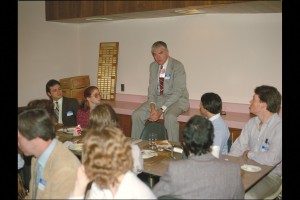
In August 2012, NASA Chief Knowledge Officer and Academy of Program/Project and Engineering Leadership Director Ed Hoffman sat down with Hans Mark, from the University of Texas at Austin, and NASA’s Jack Boyd at the Ames Research Center as part of the Academy’s Masters with Masters series.
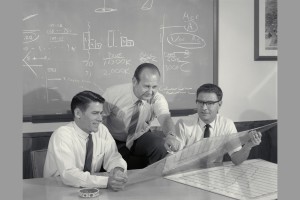
Ames engineers (left to right) Allen Faye, Merrill Mead, and Jack Boyd discuss aircraft design and handling.
Photo Credit: NASA/Ames Research Center
Dr. Mark has held several roles, including NASA deputy administrator, Ames center director, chancellor of the University of Texas, secretary and undersecretary of the air force, director of the National Reconnaissance Office, and director of research and engineering at the Department of Defense. Jack Boyd has worked at Ames for more than sixty years and is the senior advisor to the Ames center director. He has been the NASA associate administrator for management, and has also served as the acting deputy center director for Ames.
Hoffman: How did you start working together?
Boyd: I got a call from the about-to-be administrator, Jim Beggs, saying he had this young fella he wanted me to show around Ames. So Hans came and spent a day.
Mark: When I came to Ames in February of 1969, I was clueless. The person in the director’s office who taught me how to do things is Jack Boyd, because he was Harvey’s executive assistant. And then both of us worked for Edie Watson for some years, which really got us started.
Hoffman: You’re both extraordinary leaders. What do you think are the characteristics of being an exceptional leader?
Mark: I think the critical thing is the creation of an atmosphere where people can develop themselves and things can happen. Occasionally, I like the term “management by exception,” that is, you manage when you think something is going wrong and say, “Okay, we have to do something.” But, by and large, you hire people who are smarter than you are, and that works by itself. I’ve had that as a principle for sixty years now.
Boyd: I like to look for someone who loves what they are doing. Also, and I have done this most of my life, you’ve got to rely on other people to get things done. If you don’t get along with other people, you’re not going to get things done very well. We have a saying at NASA, which I mostly agree with: “Failure is not an option.” I think failure is an option in the technology world because you’ve got to try new things and sometimes you are going to fail, but don’t let that stop you from doing things. Don’t give up.
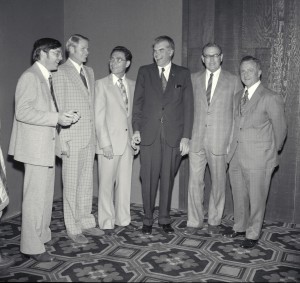
At a farewell party for Dr. Hans Mark, Ames center director from 1969 to 1977, are (left to right) Alan Chambers, Dale Compton, Jack Boyd, Hans Mark, Lloyd Jones, and John Dusterberry.
Photo Credit: NASA/Ames Research Center
Hoffman: One of the key aspects of leadership is how effective are you in times of transition, crises, and change. Both of you, at different points in NASA history, have dealt with that. What should NASA be doing today to be able to respond to a time where there is a lot of uncertainty?
Mark: Many people sitting in this room today remember the crisis we were in in 1969, after we had successfully landed on the moon. People began to say, “OK, you’ve done it. What is next?” For the next two years, there was a genuine crisis in the sense that we were cutting back, and we were doing things that were really no longer part of what administrators had in mind. I think that we got out of the crisis by changing the emphasis of the center from the Apollo program, which we all contributed to, to what we were good at. Of course, aeronautics came up first. One of the things that Roy Jackson, our boss at the time, did was initiate a new experimental aircraft program. In the eight years I was here, we developed five or six experimental aircraft. The tiltrotor aircraft came out of that. I think that is an example of making a change that revived our ability to hire people and to do things.
Hoffman: Is NASA as comfortable taking risks today as when you were providing leadership a few decades ago?
Boyd: I think generally not, but I should say that with some hesitation because we just saw one with MSL [Mars Science Laboratory], which was one hell of a risky thing to do, and we did it successfully. In the NACA [National Advisory Committee for Aeronautics] days—remember we were a very small organization—we weren’t very high on anyone else’s radar screen. So we could do what seemed to be dumb things and get away with it. Some of those dumb things turned out to be remarkable activities. For example, R.T. Jones, who developed the swept-back wing that is on every airplane that flies anywhere in the world, was not permitted to publish his paper when he first talked about it. They thought it seemed like a dumb idea: birds don’t have swept-back wings, why should we? Harvey Allen and his “blunt body,” which is on every spacecraft that goes into planetary atmosphere, we did that here.
I don’t think we’re quite in a mode today of taking those kinds of risks, but I am going to say MSL was one heck of risky activity, which was wonderfully successful.
Mark: I would answer your question by saying the biggest risk we took programmatically when I was here was to take on the development of the first large massively parallel computer, the ILLIAC IV, because no one knew how to program the thing. But we had Harv Lomax here, we had Dean Chapman, we had R.T. Jones, and then we brought in Bill Ballhaus and Paul Kutler and Ron Bailey, and a bunch of people that then sat down and made the thing work. So what did we do? We hardwired it, basically. We didn’t have an operating system or a program, but we showed that the parallel computer configuration could do a calculation in 15 minutes that took the CDC 7600 several days to do. Today, every large computer has parallel architecture. I think that had an enormous impact, and we started it right here.
Hoffman: What are your thoughts about the vision for NASA? What are some of the things that you hope for the future of what we’re doing?
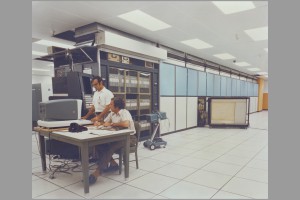
Quadrant of ILLIAC IV, the first large massively parallel computer, with V. Tosti (standing) and S. Kravity.
Photo Credit: NASA/Ames Research Center
Boyd: I’ll quote our Russian friend, Konstantin Tsiolkovsky who said, “The earth is a cradle of humankind, but you can’t stay in the cradle forever,” so we’ve got to go outside. I think Von Braun said, “Let’s do it for the fatherland.” Carl Sagan said, “Let’s do it for science.” And a guy named O’Neil, who Hans knew quite well and used to come visit us, said, “It is human destiny to explore; exploring the solar system is human destiny.” That is the way we got to do things. Now, how you go about doing it, what processes you use, what steps you take, I’ve got my own thoughts about. I’m not sure they are all that relevant now, but to go out and do those sort of things require you to be a pretty good salesmen, too, in order to get Congress and the people of the United States behind us. I wouldn’t give up on any of this. If you fail one time, don’t stop. We can’t give up.
Mark: Let me separate aeronautics from space exploration. The vision for aeronautics goes back to NACA and was driven by the fact that in World War I, the United States did not have a single combat aircraft at the front. We were way behind. So for a hundred years now, we have been the leading nation in aeronautics in the world. Aeronautics today is not quite the largest, but almost the largest manufacturing industry that still has a very large balance of trade, roughly $75 billion a year give or take. So the vision for aeronautics is clear: the United States will continue to be the leading nation in aeronautics in the world. Period. The end.
Now, what about space exploration? Aeronautics is done because we have a social imperative to do it. We have victory in war, and we have the transportation system, and there are several million people who have jobs in the aeronautics industry. This is one area where NASA should stand up and say, “We know how to make jobs!”
The space industry alone doesn’t employ that many people, but there are two issues. One is that the scientific work we’ve done in space has become very, very important. You know, I’ve heard political folks tell me we don’t really need satellites; when you go home today and drive your car, have you got GPS in front of you? Most people don’t know where it comes from. How many people know that two Nobel Prizes have been awarded for work done with NASA spacecraft? Riccardo Giacconi got the Nobel Prize for the work he did with the Chandrasekhar satellite [Chandra observatory] on X-ray astronomy. And John Mather got it for the Cosmic Background Explorer for showing that the cosmic background is not isotropic. With Earth-orbiting vehicles, we have done science that has new, genuinely important information about how the universe works. We haven’t done that yet in the planetary area, but we should do both. And in the planetary area, I think the objective must be very simple; we’re going to put people on Mars. You don’t spread it around too much. Just say that is the objective.
Audience: NASA is working on just a half a cent of the budget dollar. How and who do you recommend we send out to Congress to get the other half a cent?
Boyd: Engage the young people around the world and in this country. This summer we’ve had nine hundred students here at Ames, many of whom were foreign nationals. If we could somehow harness the power of these young folks who are really enthusiastic about what they see when they come to a place like Ames, I think that would help us tremendously.
Mark: The necessary foundation of this place has to be technical competence. If you bring a few technically competent people in, others will come. In addition to the salesmanship, there has to be technical competence. The position of a NASA center director is enormously powerful. It’s powerful not because we’re all that good at getting money from Washington. It is because we can choose people to do the jobs that we know they will do well.
Audience: Where do you see someone with less technical experience but with more management experience in NASA leadership?
Boyd: I think the management here at Ames recognized some time ago that technical excellence alone isn’t going to hack it at a research technology center. In the mid-sixties, they said, “OK, you’ve done your technical things, now we’re going to send you off to the Stanford Sloan Program because we need people who understand finance, procurement, what have you.”
I said, “I don’t want to go to the Stanford Sloan Program. That’s got to be dull.”
But I went, and it was probably one of the best experiences I had. It helped me understand where other people were coming from, too. I think that mix of the technical and engineering background, and a business background, is quite useful to me. So you need a mix, clearly.
Mark: I agree.
Hoffman: One of the things I wanted to get your thoughts on is recommendations for people starting their careers. I was mentioning a personal story I had to Hans and Jack. The first time I met both of these leaders was in 1983 as a graduate co-op student. I was doing research into leadership competencies, on how project teams perform, at Columbia University. Hans would have social events for the different co-ops, interns, and students. I had a friend coming up from Columbia, and I said, “Let’s go to the deputy administrator of NASA’s party.”
He said, “No, no, let’s not do that. That’ll be boring.”
To me, it met the number-one criteria for a graduate student: I knew it would provide free food. So I talked my friend into it. Leadership was there at the event, and there were about thirty of us students, so there was a lot of activity for the first half hour.
All of a sudden, Dr. Mark gets everyone around him at the center of the room. I’m stuffing my face and I hear Hans say, “I want to welcome all of you here to this event, particularly the students, because you’re the future of us and it’s critical that we bring on board the best. I see that we have twenty-nine of you who are aerospace engineers, and I know why you’re here. One of you is a psychology guy from Columbia, and I have no idea what you’re doing here.”
I think that mix of the technical and engineering background, and a business background, is quite useful to me.
At this point, I get this ball of sweat right on the back of my neck. I know where this is going. Hans says, “Can you identify yourself?”
I say, “I’m Ed Hoffman. I’m from Columbia University.”
He says, “Well, why are you here?”
You realize how great of a question that is. You would think someone would know why they’re at NASA, but that was the first time it really locked in. Why am I here? I said, “I’m here helping teams, how they work together, how leaders perform.”
He says, “Well, I’m a leader. Can you help me become more effective?”
I throw the question back, and I said, “Well, can you give me an example of an effective leadership practice that you use?”
He said, “Well, one of the things I like to do is write down what are called ‘Hans grams.’ I write down notes on little stickies at the end of the day and leave them with my management team. Does that make me a good leader?”
Behind him, he can’t see, but his management staff is giving all kinds of signals to tell him why it is not. So I said, “Why do you think that’s a good practice; why do you do it?”
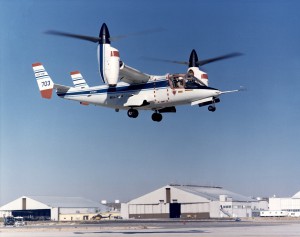
The development of the XV-15 tiltrotor research aircraft was initiated in 1973 with joint army–NASA funding as a “proof of concept,” or “technology demonstrator” program, with two aircraft being built by Bell Helicopter Textron in 1977.
Photo Credit: NASA
He said, “I communicate with my folks, they know it’s a priority, and I know when they first get in in the morning they know what I’m expecting.”
I said, “Well, based on what you’re saying, that sounds like a good practice.”
Thirty minutes later, he invites me to his office with a couple of other students, and he’s showing me different awards and medals, and he said, “By the way, I’m still totally not sure why you’re here, but I liked your answer. You handled that really well.”
That was when I had an appreciation for being prepared and what a testing organization meant, which means you should know why you’re at a place. There was a strong community then and you could go to these events and meet the leadership, and they would test you and ask questions, but mostly interact with you.
What do you recommend for folks who start at NASA, or what are your recommendations for young professionals in terms of being successful or having a career?
Boyd: First, find a mentor. Find one or more mentors.
Hoffman: How do you find a mentor?
Boyd: Most people are really happy to do it. Just talk to people. Most of them would be happy to deal with you. Be persistent if they’re not. Otherwise, get to know your colleagues as best you can. Get to know them because you’re going to work with them for the rest of your careers, for the rest of your life sometimes.
Mark: I teach a freshman course in the aerospace department, and at the end of the first and second years I always pick a group of people to send to NASA centers. NASA has this scholarship for summer jobs. I think thatand this is advice for, I might call it, “pre-professional”the people who have had intern positions and co-op positions have no problem finding jobs even today in the current environment. So, get with it early, that’s the short advice. Do it as soon as you can.
I like the term management by exceptionthat is, you manage when you think something is going wrong and say, Okay, we have to do something. But, by and large, you hire people who are smarter than you are, and that works by itself.
Hoffman: Who were your mentors?
Boyd: I had three that I remember. Harvey Allen, who was just a delightful man and brilliant. R.T. Jones was the one who told me when I got here, “Read everything that you can find out. We’ll give you six months before we give you a real job to do.”
Those two and Walter Vincente, who was another giant in the 1-by-3-foot supersonic wind tunnel. He was instrumental in teaching me how to write. Engineers are notoriously poor writers and not too good at speaking for that matter but the combination of those two, he helped me with.
Mark: Well, my father was a scientist, so obviously he was the number-one mentor. He had a student by the name of Edward Teller who became my second mentor. In the area of dealing with high-level politics and so on, I would have to say that Johnny Foster was my mentor there. We had an associate director here named John Foster, but I’m talking about the one who was in the nuclear weapons business and then went into the Pentagon. John Foster was a good physicist, and he also understood management. So I would say those three.
Hoffman: So the importance of finding a mentor is very clear, and also being able to answer the question of why you are here is one of the things that I would share. I’ve been here twenty-nine years, and this is one of those days I’ll always cherish and remember.
https://www.nasa.gov/offices/oce/appel/ask/issues/48/48i_mentor.html






